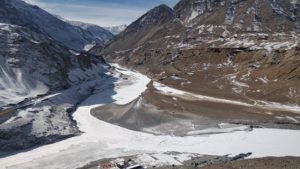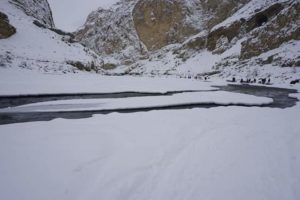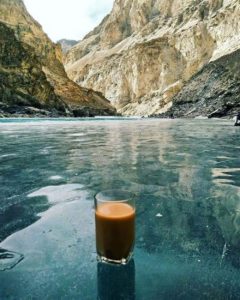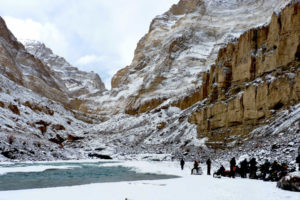





+91-9419333393
cwangdus@gmail.com
Do not hesitate to give us a call. We are an expert team and we are happy to talk to you.
+91-9419333393, +91-9469867272, +91-(0)1982- 255223
cwangdus@gmail.com






Duration : 10 Days
Grade : Hard
Chadar trek is one of the most thrilling yet a challenging one for the trekkers in Ladakh. The temperature during winter in Ladakh drops down to minus 10 to 40 degrees, yet the trekkers, the exceptional adamant one choose this trekking. This trekking is worth the challenge; it is like the path least travel and you will see the hidden or unreachable ranges of the uppermost section of the Himalayas. Since this trek demands ample of physical strength, one must be above 20 and should be physically fit. Within 5 days you will taste the chilly weather, but with the satisfaction of reaching the unseen villages and people by the rest of the world. Throughout this journey you will be accompanied by Guide, cook, helper, and porters.
NOTE:-
if there is any monastic festival during your tour in Ladakh, then we will have complete day tour to witness a monastic festival.
All the itineraries can be customized to suit your own special interests, preferences, abilities, extension and reduction of numbers of days.
Our services start with your arrival at Leh airport. Meet & greet and transfer to the Hotel. Welcome drink on arrival. We recommend you completely relax for the rest of the day to enable yourselves to acclimatize to the rarefied air at the high altitudeanda successful trek in Ladakh requires you to acclimatize well with high altitude, tourist can explore the Leh market and shanti stupa in the evening only if you feel fine. O/N hotel
Take a guided walking tour of Leh town, including a visit to Leh Palace, Known as “Lhachen Palkhar” which was built at the beginning of 17th century AD, Founder of the Namgyal dynasty of Ladakh, Tsewang Namgyal embarked on building the Leh Palace on the Tsemo Hill in 1553. The construction of this regal building was completed in the 17th century by Singey Namgyal known as the ‘Lion’ King. He was the nephew of Tsewang Namgyal. While the upper floors of the nine-storied palace were used for residential purpose by the royal family, the lower floors had storerooms and stables. Back to hotel.
After breakfast take a full day excursion to renowned monasteries and palaces of Ladakh region. Founded in 1433 by Palden Sherab. Thiksey monastery is the most beautiful monastery of Ladakh. This monastery majestically overlooks the valley, a magnificent group of about 80 monks; discovery of the beautiful inner courtyard which distributes access to the various temples. The most amazing is certainly the temple of Maitreya with its gigantic interior statue which covers all floors of the building. To join the next site, we will take the path of school children.
Founded in 1632 by Lama Staktsang Raspa. Visit Hemis Monastery, it is a Tibetan Buddhist monastery of the Drukpa Lineage. The monastery houses an amazing collection of the age-old relics such as the idol of Lord Buddha made up of copper gilt, gold and silver stupas It holds the distinction of being the biggest as well as the wealthiest monastery of Ladakh. The annual Hemis festival honoring Padmasambhava is held here in June.
Visit Shey (Built in 17th century by king Deldan Namgyal) ancient capital of Ladakh, is an interesting complex whose importance is still measured by the quality of the paintings and the astonishing quantity of chortens or other votive monuments that surround it, especially the copper gilt statue of lord Buddha. The Rock-carved statue of five Buddha can be seen below the palace on the roadside, which was probably carved during the reign of Singay Namgyal.
Built in 1825th by king Tsespal Tundup Namgyal. Stok Palace, residence of the present kings of Ladakh. Transformed into a museum , the collections presented evoke a recent past where the royal family ruled over this valley. O/N hotel
In the morning after breakfast drive towards Nimoo where the confluence of river Zanskar and Indus is located, from there take left and drive along the Zanskar River till you reach Sumdou. At Chiling after Lunch visit the White Copper artists famous for their handmade works. After lunch drive Shingra Yokma from where the expedition will start till you reach Shingra-gongma ( 1-2hrs). Today is the day you will actually start walking on the frozen river, we will pitch your camp at the bank of Zanskar River. As the dusk ascent the coldness will arise too, your sleeping bag and the warm water will keep you warm. Spend your night in the tent. O/N tented camp
In the moring after having your breakfast with a hot cup of tea to beat the freezing weather and energise you for yet another challenging 5hrs trek to Dip. Starting this trek to Dip where you’ll see numbers of caves, and you will also see Tsomo Paldar, naturally flowing spring water. After a day long trek you will set your tent at Dip for your night stay. O/N tented camp
Start the trek from Dip, after 4-5 hrs of walk you will be reaching Nyerak pulu. After Lunch visit the Big water fall and beautiful village called Nyerak. Reaching this village you will get to know about Zanskar people and its way of life. From there Singey-La will be visible. O/N camp
On the way back you will take the same route back from Nyerak pulu to Dip Yokma. Spend the night in camp at the side of river bank. O/N tented camp
Trek back from Dip Yokma to Shingra Yokma.Overnight in Camp at the side of river bank. O/N tented camp
Trek back from Shingra gongma to Shingra Yokma and then drive back to Leh bidding farewell to the adventurous yet a challenging trekking. O/N hotel
Early morning transfer to airport to board flight back to home and tour ends with sweet memories.
Pay heed to the guidelines given by trek leader or instructor in order to enjoy a safe and sound trekking experience. Avoid trekking during the nights. Single rooms and tents can be requested for a supplement (subject to availability). Please enquire at the time of booking.
Ladakh is very safe, tourist friendly and cheering place, but still you need to take care of some preparations which can make your tour even better and memorable: Carry headache, stomachache, anti-vomiting tablets with you. Please respect the culture of Ladakh. We are Providing world class services in the secluded place, which is similar to an oasis, is very difficult and challenging. Still we try our best to bring cheer on your faces.
Code of Ethics for tourists visiting Ladakh
Eating and Drinking
Whilst camping, the staff will bring a hot drink (usually tea) to your tent each morning. When you reach camp in the afternoon tea and biscuits will be served. At breakfast, dinner and in the afternoons, there is a choice of hot drinks. Breakfasts typically include cereal, toast and jam, eggs and porridge. Lunch on trek is usually served as a picnic en route (except on shorter days when it is in camp). Lunch and dinner typically include soup to start, followed by a variety of hot dishes (both local and western) such as potatoes/chips, vegetables, curry, pasta, rice, dal and paneer (cottage cheese). At dinner time a dessert such as tinned fruit and custard, fritters or cake is also be served. Note:- that although some meals will include meat, it is not as readily available while camping.
Drinking Water
Staying hydrated is important when undertaking any physical activity but particularly so at altitude where it is generally recommended to drink at least 3-4 litres per person per day.
We strongly encourage you not to buy bottled water as this contributes to the growing problem of plastic pollution in Ladakh. In Leh there is a shop called Dzomsa which sells safe drinking water (but in winter this shop may remain closed). Your leader will show you where this is on your first day in Leh.
During the trek the cooks will collect and boil drinking water from the mountain streams and fill up your water bottles for you, but you may need to collect water during the day and may wish to use your own water purification treatment as well.
We also suggest that you may like to bring a reusable bottle with a wide opening (Nalgene or similar)
Weather
Ladakh in winter is very cold. From January to March the days can be sunny but there will be a chill in the air. January is the coldest month in Ladakh. By March the days can be up to 7°C The early mornings, evenings and night times will be extremely cold. You must be prepared for temperatures well below freezing. Daytime temperatures in Leh, and on trek, will be from approximately – 10°C to + 6°C. It is a very dry cold in Ladakh and we can expect sunny weather with a wind chill. Night-time temperatures can drop to – 10°C down to – 25°C.
What to bring
Hiking trousers and shirts, warm jackets, pullovers and raincoat Good hiking shoes Flash light Sun hat/baseball cap Sunglasses, Lip balm Sun lotion cream and toiletries
